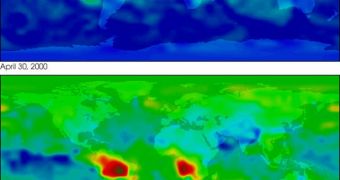Very low-altitude airborne measurements of greenhouse gases were recently made possible by a new unmanned aerial vehicle operated by the American space agency. The aircraft flew over several sites in California and Nevada, collecting relevant pollution data.
The new asset was developed in Moffett Field, California, at the NASA Ames Research Center. Its primary use is to measure carbon fluxes with extreme accuracy. The data can then be used to inform a variety of policies and computer models.
In addition, understanding Earth's carbon cycle also involves figuring out carbon sources and sinks – location where the chemical is trapped. Sources include man-made pollution, wildfires and permafrost, for example, while forests, certain rocks and the ocean are naturally-occurring sinks.
During the new science flights, experts managing the Sensor Integrated Environmental Remote Research Aircraft (SIERRA) also tested newly-installed capabilities, such as for example a carbon dioxide, methane, and water vapor instrument.
While this aircraft can be used as a stand-alone tool, it is currently being operated as part of a network of NASA assets dedicated exclusively to figuring out how carbon moves through all of Earth's systems.
The American space agency currently has access to an ever-expanding fleet of unmanned drones, which it outfits with a wide variety of scientific instruments. These probes are then sent on dangerous, low-altitude missions, which are to be avoided by human pilots.
“Understanding the magnitude and location of carbon fluxes is important for improving our understanding of how ecosystems influence the composition of the atmosphere and the balance of climatically important gases,” Laura Iraci explains.
“Tower networks currently provide important information but their distribution is pre-defined. Aircraft can play an important role by enabling measurements where towers don't or can’t exist, and in studying systems with features that move in time,” she goes on to say.
The expert holds an appointment as a researcher at ARC, and is also the principal investigator of the NASA science team conducting the SIERRA experiments. She explains that certain areas have to be analyzed from altitudes as low as 30 meters (100 feet).
UAV are excellently equipped to handle such missions. The low altitude is unsafe for human pilots, but the drones can conduct studies under these conditions without any problem.
In the near future, UAV such as SIERRA will be used to augment data from missions such as the NASA Orbiting Carbon Observatory 2 and 3, and the Active Sensing of Carbon Dioxide Emissions over Nights, Days and Seasons (ASCENDS) spacecraft.

 14 DAY TRIAL //
14 DAY TRIAL //